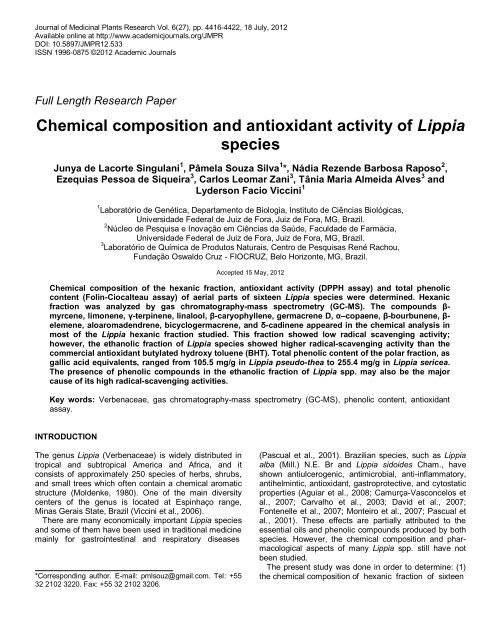Download Complete Issue (4740kb) - Academic Journals
Download Complete Issue (4740kb) - Academic Journals
Download Complete Issue (4740kb) - Academic Journals
You also want an ePaper? Increase the reach of your titles
YUMPU automatically turns print PDFs into web optimized ePapers that Google loves.
Journal of Medicinal Plants Research Vol. 6(27), pp. 4416-4422, 18 July, 2012<br />
Available online at http://www.academicjournals.org/JMPR<br />
DOI: 10.5897/JMPR12.533<br />
ISSN 1996-0875 ©2012 <strong>Academic</strong> <strong>Journals</strong><br />
Full Length Research Paper<br />
Chemical composition and antioxidant activity of Lippia<br />
species<br />
Junya de Lacorte Singulani 1 , Pâmela Souza Silva 1 *, Nádia Rezende Barbosa Raposo 2 ,<br />
Ezequias Pessoa de Siqueira 3 , Carlos Leomar Zani 3 , Tânia Maria Almeida Alves 3 and<br />
Lyderson Facio Viccini 1<br />
1 Laboratório de Genética, Departamento de Biologia, Instituto de Ciências Biológicas,<br />
Universidade Federal de Juiz de Fora, Juiz de Fora, MG, Brazil.<br />
2 Núcleo de Pesquisa e Inovação em Ciências da Saúde, Faculdade de Farmácia,<br />
Universidade Federal de Juiz de Fora, Juiz de Fora, MG, Brazil.<br />
3 Laboratório de Química de Produtos Naturais, Centro de Pesquisas René Rachou,<br />
Fundação Oswaldo Cruz - FIOCRUZ, Belo Horizonte, MG, Brazil.<br />
Accepted 15 May, 2012<br />
Chemical composition of the hexanic fraction, antioxidant activity (DPPH assay) and total phenolic<br />
content (Folin-Ciocalteau assay) of aerial parts of sixteen Lippia species were determined. Hexanic<br />
fraction was analyzed by gas chromatography-mass spectrometry (GC-MS). The compounds βmyrcene,<br />
limonene, γ-terpinene, linalool, β-caryophyllene, germacrene D, α–copaene, β-bourbunene, βelemene,<br />
aloaromadendrene, bicyclogermacrene, and δ-cadinene appeared in the chemical analysis in<br />
most of the Lippia hexanic fraction studied. This fraction showed low radical scavenging activity;<br />
however, the ethanolic fraction of Lippia species showed higher radical-scavenging activity than the<br />
commercial antioxidant butylated hydroxy toluene (BHT). Total phenolic content of the polar fraction, as<br />
gallic acid equivalents, ranged from 105.5 mg/g in Lippia pseudo-thea to 255.4 mg/g in Lippia sericea.<br />
The presence of phenolic compounds in the ethanolic fraction of Lippia spp. may also be the major<br />
cause of its high radical-scavenging activities.<br />
Key words: Verbenaceae, gas chromatography-mass spectrometry (GC-MS), phenolic content, antioxidant<br />
assay.<br />
INTRODUCTION<br />
The genus Lippia (Verbenaceae) is widely distributed in<br />
tropical and subtropical America and Africa, and it<br />
consists of approximately 250 species of herbs, shrubs,<br />
and small trees which often contain a chemical aromatic<br />
structure (Moldenke, 1980). One of the main diversity<br />
centers of the genus is located at Espinhaço range,<br />
Minas Gerais State, Brazil (Viccini et al., 2006).<br />
There are many economically important Lippia species<br />
and some of them have been used in traditional medicine<br />
mainly for gastrointestinal and respiratory diseases<br />
*Corresponding author. E-mail: pmlsouz@gmail.com. Tel: +55<br />
32 2102 3220. Fax: +55 32 2102 3206.<br />
(Pascual et al., 2001). Brazilian species, such as Lippia<br />
alba (Mill.) N.E. Br and Lippia sidoides Cham., have<br />
shown antiulcerogenic, antimicrobial, anti-inflammatory,<br />
antihelmintic, antioxidant, gastroprotective, and cytostatic<br />
properties (Aguiar et al., 2008; Camurça-Vasconcelos et<br />
al., 2007; Carvalho et al., 2003; David et al., 2007;<br />
Fontenelle et al., 2007; Monteiro et al., 2007; Pascual et<br />
al., 2001). These effects are partially attributed to the<br />
essential oils and phenolic compounds produced by both<br />
species. However, the chemical composition and pharmacological<br />
aspects of many Lippia spp. still have not<br />
been studied.<br />
The present study was done in order to determine: (1)<br />
the chemical composition of hexanic fraction of sixteen

















